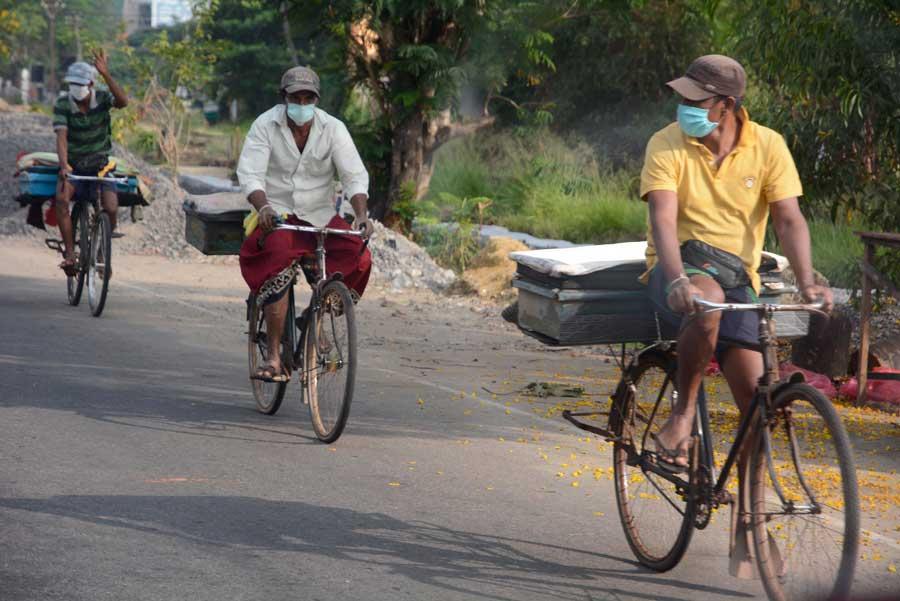Economic fallout of COVID-19

Struggling for day-to-day survival: A group of fish sellers on business during the ‘lockdown’ to Covid 19 in Sri Lanka – Pic by Kithsiri de mel

While the government’s response to COVID-19 may have shielded Sri Lanka from a major loss of life, the imminent large-scale economic fallout will be harder to prevent. The country has been struggling with low economic growth in 2019/20, poor export growth, a decline in tourism and high currency depreciation. With many economists predicting an oncoming global recession or depression similar to the 1930s Great Depression, it is evident that Sri Lankans will face many hardships ahead.
Pre-existing problems
According to experts, Sri Lanka’s pre-existing economic problems will
exacerbate the COVID-19 recession. According to Murtaza Jafferjee, CEO
of JB Securities and a director at Colombo Stock Exchange (CSE), Sri
Lanka has needed major structural reform for years.
“Sri Lanka’s economic policy has been protectionist and nationalist
since the beginning of the war. These policies were never altered. This
has led to a domestic industry that has not been focused on increasing
productivity,” he opined. “The economy has relied on high tariffs on
imports; for instance, furniture faces an import tax of up to 45%. This
lack of competitiveness and increase in productivity have led to an
ever-widening trade deficit. The trade deficit rose from $7.6 billion in
2013 to $10.3 billion in 2018. There has been little export-sector
growth in the past decade. For instance, in 2019, agricultural exports
declined by 4.6% and tea exports by 5.7%. The end result is a
non-competitive economy in desperate need of reform and which will be
hit especially hard by the decline in demand for Sri Lankan exports in
the coming months.”
Agreeing that the local economy had many structural constraints, Deshal
de Mel, Research Director at Verité Research, pointed to debt overhang,
weak export diversification, suboptimal labour force participation and
lack of fiscal space as underlying problems.
“Many local businesses are struggling to adapt to the idea of working from home. Moreover, workers who cannot work from home have been severely impacted. This consists most of the workforce as Sri Lanka has a high focus on primary and secondary production sectors”
“Fiscal space is an important indicator of government financial
well-being and is defined by the International Monetary Fund (IMF) as a
government’s ability to raise spending or lower taxes without
endangering market access and putting debt sustainability at risk,” he
said. “When the starting budget deficit is an optimistic 7.5% of GDP
compared to a global median deficit of 2%, it is clear that Sri Lanka
has left itself with little fiscal space and
| Murtaza Jafferjee |
resilience to respond to a crisis of this nature.”
However, Mr. Jafferjee blamed election-based government policy. For
instance, lowering taxes to incentivise consumption had greatly
increased national debt. Developing infrastructure, partly funded by
foreign capital, has also worsened debt. “We lack the competitiveness
from tradeable sectors to generate foreign exchange to repay this debt.
It is a balance of payments crisis,” he said.
Meanwhile, Prof. Sumanasiri Liyanage of the Peradeniya University said
the economy had been in recession for the last five years. “The new
government thought it could revive the economy. The Central Bank (CB)
Governor envisioned a 4% economic growth in 2020. However, because of
the coronavirus pandemic, I reckon the growth rate will not exceed 2%,”
Prof. Liyanage said while Mr. Jafferjee forecast negative growth in
2020, a phenomenon not seen since 2001.
Oncoming decline
Our economy depends heavily on tourism, tea and textile exports, but
demand in these sectors is expected to decline. Prof. Sirimal Abeyratne
of the Colombo University said exports would be greatly affected. “The
oncoming recession will hit Sri Lanka harder than the Easter bombings,”
he said.
Prof. Liyanage agreed saying there would be widespread supply-side
shortages, particularly in textiles. “One reason is because it is
difficult to get workers to factories. The second is because many
factories in China have closed and these are the main supplier of raw
materials.” Prof. Ricardo Hausmann of the Harvard Growth Lab noted in a
video-conference recently that supply-side shortages would “percolate
through the economy,” leading to shortages of materials and eventual
reduction in demand, causing an increase in layoffs and bankruptcies. He
added that the impact on developing nations like Sri Lanka would be a
“collapse in access to foreign income.”
The crisis has been further heightened by Sri Lanka’s dependence on the consumption of developed countries.
| Deshal de Mel |
Niluka Ekanayake of the CB Economic Research Department citing a 2016
study said the US accounted for 42% of garment exports while the EU
share was 46%. “These developed nations will greatly reduce consumption
of Sri Lankan garments,” Mr. Jafferjee said. Sri Lankan textiles cater
to luxury brands like Tommy Hilfiger and Victoria’s Secret whose prices
would be excessive during economic strife. “Why shop from there when you
can purchase something basic from Amazon for a tenth of the price?” he
asked.
Citizens from the west also dominate our tourism industry, which
accounts for 20% of national GDP. So even if the government contained
COVID-19, tourism demand would likely drop until the economies of these
countries recover. With Goldman Sachs predicting a 24% fall in the US
GDP in the second quarter of 2020, and Morgan Stanley predicting a 30%
fall, rapid economic recovery in the west appears unlikely. And Jim
Rogers, Chairman of Rogers Holdings Inc. and co-founder of Quantum Fund,
has predicted the worst ‘bear market’ in his lifetime – A bear market
is when negative investor sentiment causes widespread falls in share
prices.
Furthermore, tea exports will decline due to high prices and dwindling
markets. Recent data from the Tea Exporters Association show Ceylon tea
sells for $3.35 per kg whereas Kenyan tea sells for $2.12 per kg. This
would harm demand for Ceylon tea in a recession, Mr. Jafferjee said.
“Most Sri Lankan tea is exported to oil-producing Middle Eastern
nations. The economies of those nations have collapsed,” he said. The
falling price of oil, now at an 18-year low, has devastated the
economies of countries like Kuwait. “If consumers from these nations get
used to cheaper tea, they might not return to Sri Lankan tea after the
downturn ends,” Mr. Jafferjee said.
Mr. Jafferjee noted a fall in remittances from Sri Lankan workers abroad
would cause an economic slowdown. In 2018, we received remittances of
over $7 billion, accounting for 7.9% of GDP, well ahead of apparel ($5
billion), tourism ($4.4 billion) and agricultural exports ($2.7
billion).
“Many Sri Lankans work in badly-hit countries like South Korea, the
Middle East and Italy. Many may not be able to send money home. It’s
probable that those in low-wage jobs, like domestic workers, will be
laid-off in the coming months,” he said. However, Prof. Abeyratne was
optimistic about certain industries. “Agriculture will be less affected
as it is based on local demand,” he said, adding that the public sector
would not suffer as much.
Government response
Many local businesses are struggling to adapt to the idea of working from home. Moreover, workers who cannot work from home have been severely impacted. This consists most of the workforce as Sri Lanka has a high focus on primary and secondary production sectors. Daily-wage earners who comprise over 60% of workers are also
| Prof. Sumanasiri Liyanage |
severely impacted. Millions of rural farmers and the self-employed
are among the hardest hit. Already, some 400 tonnes of fish have been
thrown away, and this may increase as more fishing vessels return to
port.
Mr. de Mel supported any government decision to aid vulnerable citizens.
“The priority of government policy has to be to minimise human
suffering. The government will have to find resources to provide cash
transfers, more than on a one-off basis, to this vulnerable segment of
the economy. Public finance resources will also need to be found to fund
testing capacity, hospital bed capacity and other critical health
resources,” he said.
The Cabinet decision to impose import controls on non-essential items,
except oil and pharmaceuticals, to prevent currency devaluation, has
also been criticised. Analysts argue this could discourage investment
when most needed. They fear such protectionism would discourage
efficiency and productivity, especially as pre-1977 import-substitution
harmed economic efficiency and dampened growth. Such policies have also
led to a rapid depreciation of the currency, as in the mid-1970s. That
crisis was exacerbated because Sri Lanka was running a budget deficit
due to successive governments subsidising commodities and providing free
entitlements to citizens, which further increased import demand and
widened the trade deficit. Similar policies are being implemented today
and Mr. Jafferjee described the nation as having a spending problem. “We
have insufficient taxation and mispriced energy such as the cheapest
diesel in South Asia and a ridiculously-low lifeline rate on electricity
of Rs. 3 per unit for the first 30 units. Import controls were
instruments used during the 1970s. I think the country has come a long
way since then and the current situation with reserves at a healthy $7.5
billion does not warrant such actions,” he said.
Contrarily, Mr. de Mel felt the decision, though undesirable, was
essential to maintain those reserves. “More than currency defence, these
measures would be required to protect reserves in the short-term. In
2020, Sri Lanka’s external liability payments are around $ 6 billion
while reserves as of February were $ 7.9 billion,” he said. Some experts
have urged the government to abandon its curfew policy due to it being
economically unsustainable. Mr. de Mel opined the government would need
to find some middle-ground, “possibly where the elderly and
immune-compromised are sheltered, and the economy is gradually opened up
in a limited manner for others, to allow people to earn some livelihood
to enable survival.”
Stimulus plan
Experts have urged the government to ramp up stimulus spending to
help individuals and businesses survive. While many countries have
launched stimulus packages of billions or even trillions of dollars, Sri
Lanka has done very little, leaving its citizens, especially daily-wage
earners, with few options. The President instructed the Export
Development Board (EDB) to submit a proposal with a stimulus plan nearly
three weeks after EDB head Prabhash Subasinghe sought a stimulus plan.
Mr. Jafferjee supported a stimulus package and urged the government to
provide at least Rs. 20,000 per household per month. “That is sufficient
for basic sustenance,” he said.
Shiran Fernando, Chief Economist at the Ceylon Chamber of Commerce,
supported this view. “We have seen foreign governments announcing large
stimulus packages supporting workers, the public and the firms. We may
need to see something similar to encourage the economic recovery after
the current stage of containment,” he said.







